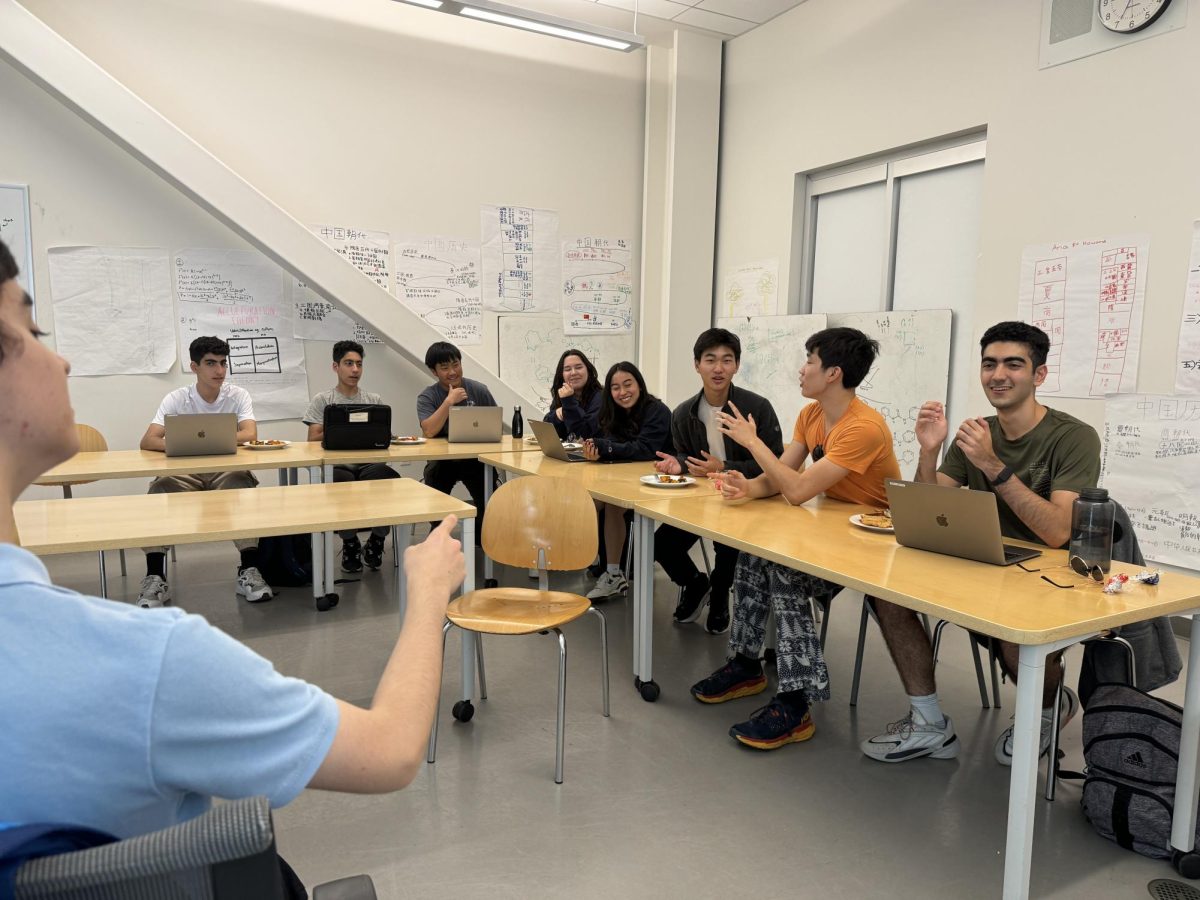
Kian S.
A meeting of the 2023-24 Research at Nueva team
In 2022, I joined a small group of students led by Houjun (Jack) Liu ’23 and former Nueva teacher Luke De. We were all interested in research and had a personal stake in our education. Our goal was to dissect the meaning of a Nueva class, stripping it of every structure imaginable, until we were left with the bare essentials.
Then, we developed a new pedagogy, in collaboration with teachers like Jehnna Ronan and Ted Theodosopoulos, that centered student leadership, research-specific skills, and an extracurricular structure in an effort to reimagine learning at Nueva. After many weekly team meetings, faculty interviews, and pilot projects, the Research at Nueva initiative was born.
Now, to reflect on what I learned diving into pedagogy over the past 3 years, I’d like to look back and answer the question that inspired me in the first place: What does a student-driven education look like? Through the themes I touch on, I hope to inspire other people to grow curious and embark on their own explorations.
Peer mentorship, student agency, and collaboration
First, what does reimagining their pedagogy look like for Nueva teachers? To Science Teacher Jehnna Ronan, who co-teaches Nueva’s multi-year Biology Research Teams (BRT) class sequence, it is emphasizing collaboration through her curriculum.
In the first year of BRT, Ronan helps students build the muscle of incorporating feedback to become better collaborators and leaders through questionnaires where students rate their own work habits on a sliding scale (e.g., “I’m more detail-oriented” or “I’m more big picture”) and provide each other feedback on group dynamics. Then in the second year, students team up to conduct a yearlong research project, where more experienced students mentor newer ones.
To Ted Theodosopoulos, reimagining pedagogy means foregrounding student agency through modules where students work in groups to create an open-ended artifact they present to the class in a symposium format. “Projects have multiple ways of being interpreted,” Theodosopoulos described. “And that’s a feature, not a bug. That’s something that would encourage genuine conversation and collaboration.” Openness guides discovery (Yanai & Lercher, 2025).
Skills over content
Research-specific skills like documentation, knowledge extraction, communication, data analysis, and project management, are broadly applicable and drive learning and discovery. Nueva students and educators have thought of creative ways to prioritize transferable research skills as the primary outcome.
With Research at Nueva, we split these skills into actionable project deliverables—we call them nodes—that each involve a clear learning goal, avenues for achievement in classes, and instructions on how to demonstrate proficiency. In her BRT class, Ronan assesses students’ scientific journal reading through the depth of their reflections and iteration on their reading strategies, which are tracked in individual “literature diaries.” Meanwhile, Theodosopoulos assesses whether students understand the unique perspectives—“lenses”—of his various classes through the artifacts students create in each module and the questions they ask. After taking a class, the facts may become obsolete over time, but your newfound way of thinking about the world and the ability to switch lenses will remain with you.
No right or wrong answer
It’s common (and honestly, comforting) to think that in classes, we are searching for the right answer that is just around the corner. But that view inherently values rightness over wrongness, and to Theodosopoulos, being wrong is a core part of his pedagogy. In fact, he makes a concerted effort not to know the right answers when creating projects. “My gauge for the quality of a project is when [not knowing the answers] becomes difficult, when I really want to engage with it,” he said. To Ronan, success as a teacher looks like increasing resilience among students. She wants “kids [to] experience failures and both bounce back emotionally by leaning on their teammates and their teachers and also move forward to iterate and make progress.”
Community
I see research as an ecosystem connecting classes, clubs, and independent projects, and in my time at Nueva, I have developed the belief that the basic components of that ecosystem are here. For example, classes like Ronan’s BRT and Theodosopoulos’s Models of Group Decisions work closely with the student-led DATAS (Discussions And Talks About Science) and Roundtable clubs, respectively.
Last year, the Research at Nueva team and I organized a school-wide research symposium that brought together students investigating schizophrenia in worm models, exploring the role of Pauli matrices in quantum information, modeling the effects of dollarization on the Argentinian economy, and adapting a traditional Chinese story into a published children’s book. The wealth of knowledge and interdisciplinary conversations were incredible. And the value of this research lies in sharing it with the larger community: all of our collaborations and feedback, skills and lenses, right and wrong answers. That is what a student-driven education looks like. Now, it’s in future Mavericks’ hands to explore.
Thank you, Ted and Jehnna, for your mentorship of Research at Nueva. Also, thanks to our leadership team and all the students, faculty, and administrators who supported our efforts to reimagine pedagogy.